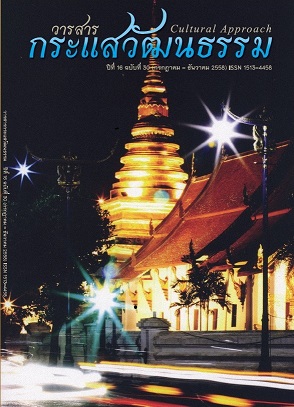การพัฒนาความรู้และความซาบซึ้งในนาฏศิลป์ล้านนาของนักเรียนมัธยมศึกษาโรงเรียนประจำจังหวัดลำพูนและจังหวัดลำปาง
Main Article Content
บทคัดย่อ
การวิจัยครั้งนี้ได้แบ่งการวิจัยออกเป็น 2 ระยะ ดังนี้ การวิจัยครั้งนี้ได้แบ่งการวิจัยออกเป็น 2 ระยะ ดังนี้
ระยะที่ 1 เป็นการวิจัยเชิงสำรวจ (Survey Research) โดยมีวัตถุประสงค์เพื่อสร้างรูปแบบการพัฒนาความรู้และความซาบซึ้งในนาฏศิลป์ล้านนาของนักเรียนมัธยมศึกษาโรงเรียนประจำจังหวัดลำพูนและจังหวัดลำปางกลุ่มตัวอย่างที่ใช้ในการวิจัยระยะที่ 1 คือ การขอประชุมระดมความคิดเห็นอย่างมีส่วนร่วมของผู้สอนนาฏศิลป์ล้านนาโรงเรียนประจำจังหวัดลำพูนและจังหวัดลำปาง ผู้เชี่ยวชาญด้านนาฏศิลป์ล้านนา ปราชญ์ชาวบ้าน และนักเรียนมัธยมศึกษาโรงเรียนประจำจังหวัดลำพูนและจังหวัดลำปาง จำนวน 20 คน ผลการศึกษาชี้ให้เห็นว่าปัจจัยที่ส่งผลต่อการพัฒนาความรู้และความซาบซึ้งในนาฏศิลป์ล้านนา จำแนกเป็นปัจจัยภายใน ได้แก่ การสร้างแรงจูงใจ และปัจจัย ภายนอก ได้แก่ การสนับสนุนทางสังคม การได้รับตัวแบบที่เหมาะสม อิทธิพลของสื่อ/เทคโนโลยี ซึ่งจากผลการศึกษาในระยะที่ 1 ผู้วิจัยได้นำมาสร้างเป็นรูปแบบการพัฒนา และออกแบบกิจกรรมการพัฒนาความรู้และความซาบซึ้งในนาฏศิลป์ล้านนา
ระยะที่ 2 เป็นการวิจัยเชิงกึ่งทดลอง (Quasi - Experimental Research) มีวัตถุประสงค์เพื่อนำรูปแบบไปทดลองใช้ในการพัฒนาความรู้และความซาบซึ้งในนาฏศิลป์ล้านนา กลุ่มตัวอย่างที่ใช้ประกอบด้วยนักเรียนมัธยมศึกษา จำนวน 160 คน แบ่งเป็นกลุ่มทดลอง 80 คน และกลุ่มควบคุม 80 คน ผลการทดลองแสดงให้เห็นว่า คะแนนเฉลี่ยความรู้และความซาบซึ้งในนาฏศิลป์ล้านนาของนักเรียนกลุ่มทดลองทั้งก่อนและหลังการทดลอง มีคะแนนเฉลี่ยแตกต่างกัน อย่างมีนัยสำคัญทางสถิติกล่าวคือ นักเรียนที่เข้าร่วมกิจกรรมการพัฒนาฯ มีความรู้และความซาบซึ้ง สูงขึ้น และสูงกว่านักเรียนที่ไม่ได้เข้าร่วมกิจกรรมการพัฒนาฯ ดังนั้น จึงสรุปได้ว่าการพัฒนาความรู้และความซาบซึ้งในนาฏศิลป์ล้านนา สามารถพัฒนาได้ด้วยรูปแบบและกิจกรรมการพัฒนาที่ผู้วิจัยได้สร้างขึ้น
Article Details
Proposed Creative Commons Copyright Notices
1. Proposed Policy for Journals That Offer Open Access
Authors who publish with this journal agree to the following terms:
- Authors retain copyright and grant the journal right of first publication with the work simultaneously licensed under a Creative Commons Attribution License that allows others to share the work with an acknowledgement of the work's authorship and initial publication in this journal.
- Authors are able to enter into separate, additional contractual arrangements for the non-exclusive distribution of the journal's published version of the work (e.g., post it to an institutional repository or publish it in a book), with an acknowledgement of its initial publication in this journal.
- Authors are permitted and encouraged to post their work online (e.g., in institutional repositories or on their website) prior to and during the submission process, as it can lead to productive exchanges, as well as earlier and greater citation of published work (See The Effect of Open Access).
Proposed Policy for Journals That Offer Delayed Open Access
Authors who publish with this journal agree to the following terms:
- Authors retain copyright and grant the journal right of first publication, with the work [SPECIFY PERIOD OF TIME] after publication simultaneously licensed under a Creative Commons Attribution License that allows others to share the work with an acknowledgement of the work's authorship and initial publication in this journal.
- Authors are able to enter into separate, additional contractual arrangements for the non-exclusive distribution of the journal's published version of the work (e.g., post it to an institutional repository or publish it in a book), with an acknowledgement of its initial publication in this journal.
- Authors are permitted and encouraged to post their work online (e.g., in institutional repositories or on their website) prior to and during the submission process, as it can lead to productive exchanges, as well as earlier and greater citation of published work (See The Effect of Open Access).
References
[2] ธีรยุทธ ยวงศรี. (2540). การดนตรี การขับ การฟ้อน ล้านนา. เชียงใหม่: สุริวงศ์บุ๊คเซ็นเตอร์.
[3] นงเยาว์ กาญจนจารี. (2533). ดารารัศมี. กรุงเทพมหานคร: โรงพิมพ์ทรีดีการพิมพ์.
[4] นรินทร์ชัย พัฒนพงศา. (2542). การสื่อสารรณรงค์เชิงยุทธศาสตร์เพื่อเปลี่ยนพฤติกรรมมนุษย์เน้นการเจาะจงกลุ่ม. กรุงเทพฯ: รั้วเขียว.
[5] ราชบัณฑิตยสถาน. (2542). พจนานุกรมฉบับราชบัณฑิตยสถาน. กรุงเทพฯ: ไทยวัฒนาพานิช.
[6] สุรพล ดำริห์กุล. (2542). ล้านนา สิ่งแวดล้อม สังคมและวัฒนธรรมโครงการสืบสานมรดกวัฒนธรรม.กรุงเทพฯ: คอมแพคชรินท์ จำกัด.
[7] สุรินทร์ พิศสุวรรณ. (2556). อาเซียน รู้ไว้ได้เปรียบแน่. พิมพ์ครั้งที่ 6. กรุงเทพฯ: อมรินทร์.
[8] อุดม เพชรสังหาร. (2551). การค้นพบทางประสาทวิทยาศาสตร์นวัตกรรมทางการศึกษา. กรุงเทพฯ: กระทรวงศึกษาธิการ สำนักเลขาธิการสภาการศึกษา สำนักมาตรฐานการศึกษาและพัฒนาการเรียนรู้.
[9] Cobb, S. (1976). Social Support as a Moderator of Life Stress. Psychosomatic Medicine. 38(5), 77-78, 300-314.
[10] Gottlieb, B. H. (1985). Social Support as a Moderator of Life Stress. Psychosomatic Medicine. 38(3), 300 - 313.
[11] Naisbitt, J. (1994). Global Paradox by John Naisbitt. William Morrow& Co.
[12] Kahn, R. (1979). Aging and Social Support. In M. W. Riley, Aging from Birth to Death: An Interdisciplinary Perspective (pp.72-92). Boulder, Co: Westview.
[13] Ormrod, J. E. (1999). Human Learning. 3rd Edition. New Jersey: Prentice-Hall.

